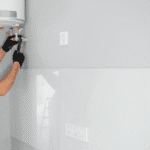Last Updated on May 18, 2025 by Rida Gul
Table of Contents
Introduction
Flickering light bulbs can signal anything from minor issues, like a loose bulb, to complex electrical problems that may lead to safety hazards. Knowing why flickering occurs and how to address it can keep your home safe and well-lit.
From simple fixes like tightening a bulb or switching to compatible dimmers to professional assistance for wiring or overloaded circuits, this guide covers the main reasons behind flickering and offers practical solutions for a stable lighting environment.
| Flickering Light Bulbs | Details |
| Causes | Flickering can stem from a loose bulb, overloaded circuits, or poor wiring, which can pose fire hazards. |
| Tips for Avoiding | Consider long-lasting, energy-efficient LED smart bulbs. |
| Quick Checks | Tighten the bulb, check the plug, tap the fixture lightly for flickering, or swap dimmer switches. |
| Advanced Issues | Mismatched dimmers and loose wiring may require detailed inspection or professional assistance. |
| Large Device Interference | Flickering caused by other appliances indicates power demands affecting the lighting circuit. |
Diagnosing Flickering Light Bulbs

Start by tightening the bulb and checking the plug connections. For fixtures, tap lightly; if flickering persists, replacement may be necessary. Test dimmers with a basic switch to check compatibility and inspect wiring for looseness, especially if larger devices cause momentary flashes in lighting.
Common Causes for Flickering Light Bulbs
Loose Light Bulb
One of the simplest reasons for a flickering light bulb is a loose bulb. When the bulb isn’t properly seated in its socket, it can lose contact with the power source, causing intermittent light.
To resolve this, turn off the power and tighten the bulb carefully to ensure it’s securely in place.
Power Fluctuations
Power fluctuations or voltage drops can also cause light bulbs to flicker, especially in homes with high-energy appliances like HVAC systems. These fluctuations can affect all lights on the same circuit, causing a brief dimming or flickering.
If power fluctuations are a frequent issue, it may be worth consulting an electrician to evaluate your home’s wiring.
Dimmer Switch Compatibility
Flickering can happen if the dimmer is incompatible with the bulb type. LED bulbs may flicker if used with incompatible dimmer switches. Unlike traditional incandescent dimmers, LEDs often need specific dimmers to function properly.
Upgrading to a compatible dimmer or using smart bulbs can prevent flickering in this scenario.
Loose Electrical Connections
Loose wiring is a more serious cause of flickering light bulbs, as it can pose a risk of electrical fire. Connections can become loose over time, causing inconsistent power flow to the bulb.
Loose connections are most likely to occur within the switch, the fixture, or even at the circuit breaker. An electrician should handle this issue to ensure all connections are properly secured.
Other Causes
Circuit Overload
An overloaded circuit happens when multiple high-power devices operate on the same circuit. When the circuit can’t supply enough power to all devices, the lights may flicker. To resolve this, try redistributing appliances to different circuits or try upgrading your home’s circuit capacity.
Utility Service Issues
In some cases, flickering light bulbs can stem from issues within the local power grid. Utility service problems, such as equipment malfunctions or power surges, may cause lights to flicker in your home.
If neighbors are also experiencing similar flickering, it’s likely a utility issue. Contacting your electricity provider can help to confirm and address these issues.
Aging Wiring
Older homes with aging or degraded wiring are more susceptible to electrical issues, including flickering lights. Wires can deteriorate over time, especially if they’re subjected to environmental changes or pest interference. Old wiring poses a fire risk, so it’s crucial to replace or repair it promptly with professional help.
Arcing in Electrical Connections
Arcing occurs when electricity jumps gaps in loose or damaged connections, causing flickering or sparking. This can lead to fires; if you notice arcing or a burning smell, turn off the power and call an electrician.
Main Service Connection Issues
Loose or degraded main electrical connections, like at the meter box or breaker, can cause flickering lights. These issues need professional attention, as DIY repairs are unsafe.
How to Fix Flickering Light Bulbs?

When a flickering light bulb becomes a persistent issue, try these steps to identify and address the cause:
- Tighten the Bulb: Begin by turning off the light, allowing it to cool, and then gently tightening the bulb.
- Check the Circuit: Identify if multiple lights or only one fixture is flickering. If it’s an isolated case, the problem may be with the fixture itself.
- Test with a New Bulb: Sometimes, flickering can be due to a faulty bulb. Replace it with a new one to see if the problem persists.
- Evaluate Larger Appliances: Note if flickering coincides with the operation of high-power devices like air conditioners. If so, it may indicate a circuit overload.
Serious Concerns with Flickering Bulbs
While flickering might stem from a simple loose bulb, it can also indicate serious issues, such as overloaded circuits or poor wiring connections, potentially leading to fire hazards. Address any flickering promptly to maintain home safety.
Installing a New Light Fixture: Essential Steps

Tools Needed
- Stepladder
- Voltage tester
- Cordless drill
- Wire stripper
- Pliers
Materials
- Light fixture
- Wire nuts
Steps
- Turn Off the Circuit Breaker: Locate your electrical panel and turn off the breaker to the light fixture area to safely cut power. Switching off just the light isn’t safe enough.
- Remove Light Fixture: Unscrew and gently lower the fixture, then use a voltage tester to confirm no active current before handling wires.
- Attach New Wires: Twist the white (neutral) and black (hot) wires of the new fixture with those in the ceiling box, securing them with wire nuts. Ensure no bare wires remain visible.
- Secure Fixture: Press wires into the ceiling box and tighten the fixture to the ceiling.
- Install Bulbs and Test: Use appropriate wattage bulbs. After installing, turn on the circuit breaker and test for flickering.
Tip: Consider upgrading to long-lasting LED smart bulbs for added convenience.
When to Call a Professional?
Some flickering issues are simple fixes, but persistent flickering, arcing, or flickering across circuits may signal serious wiring or connection problems. Promptly addressing these with a licensed electrician can prevent fire hazards and maintain stable power in your home.
Conclusion
Flickering light bulbs can range from minor issues, like a loose bulb, to serious electrical problems. Addressing flickering early ensures home safety and can prevent fire risks. While you can fix minor issues yourself, certain situations, such as arcing, aging wiring, or overloaded circuits, require professional assistance. Whether it’s a simple fix or a sign of a deeper electrical issue, always prioritize safety when dealing with flickering light bulbs.
Apart from that if you want to know about “Illuminating Renovation Success: Outdoor Lighting Strategies for Your Home” then please visit our “” Category.
FAQs
Not always. Flickering can signal dying bulbs, but it often points to wiring or power issues.
Persistent flickering, sparking, or multiple flickering bulbs could indicate serious issues needing an electrician.
First, check if the bulb is tight. If that doesn’t help, check wiring connections or switch to a compatible dimmer for LED bulbs.
















